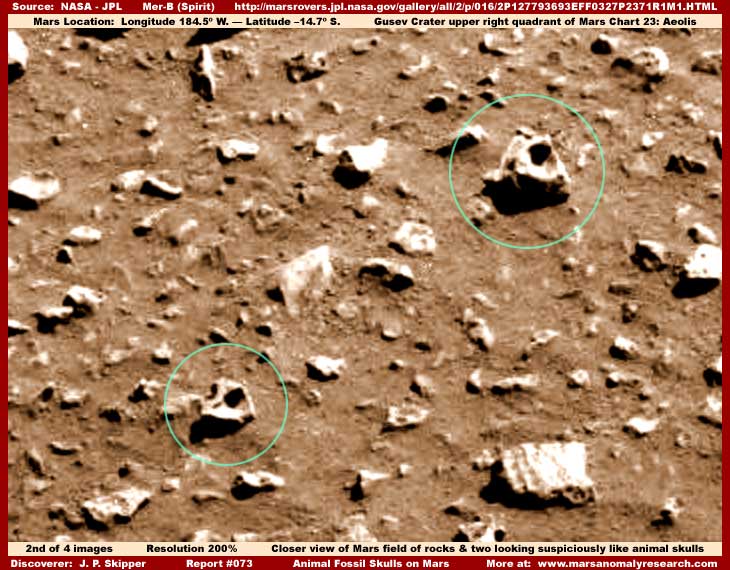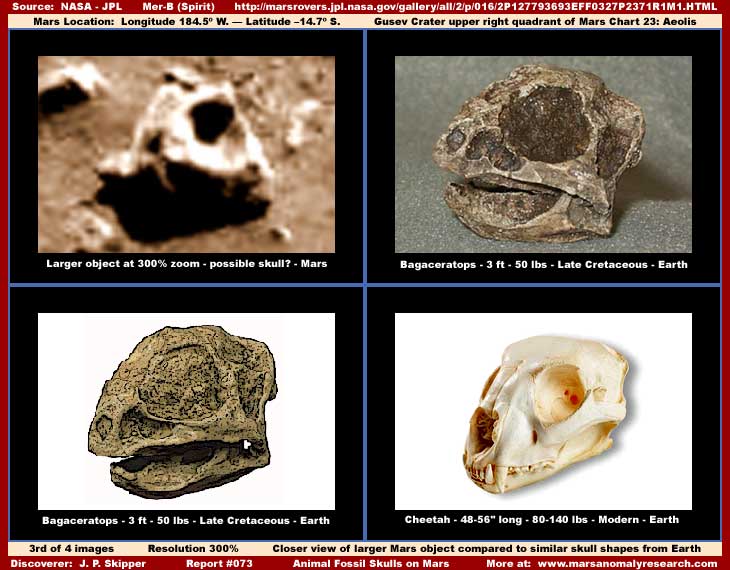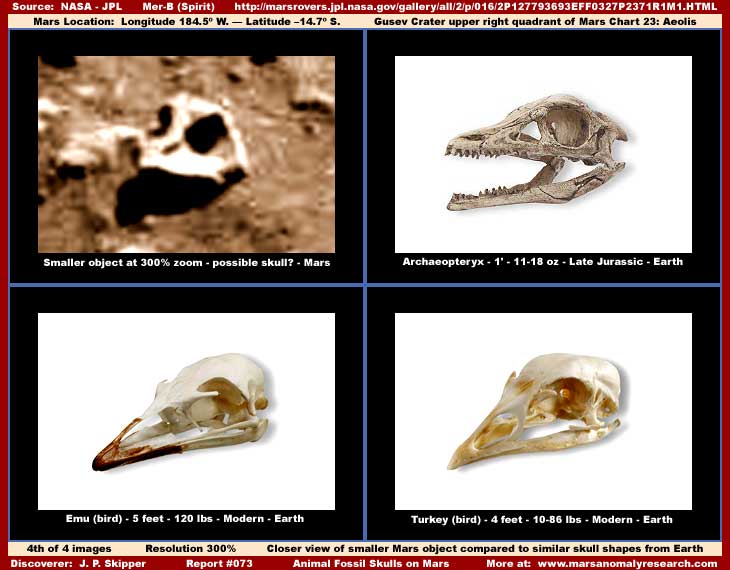
ANIMAL FOSSIL SKULLS
ON MARS
Report #073
September 5, 2004

I'll may take some heat on this report because it deals with possible Paleontological discovery evidence and I may be seen by some as stepping across boundaries and treading where I should not, again. It is often hard to get experts to agree here on Earth even when the evidence can be physically held and tested must less trying to identify this type of evidence from Mars Spirit Rover poor quality JPEG compression imaging on a distant world and where there is only one admittedly insufficient angle of view.
Still I'm going to forge ahead here because this kind of evidence on a distant world like Mars is too significant, at least in its potential, not to put it out there for others to see and consider. Also, keep in mind that this is evidence from another world and that expert experience here on Earth may not necessarily fully translate to this kind of evidence. That means that common sense interpretation is not to be treated lightly here in considering this evidence.
The above first image provides a wide-angle view of a rock field area near the Mer-A Spirit Rover on Mars. The discovery objects are not large and could be held in one or two cupped hands. I've given the image some color to provide some contrast so that all objects in this scene will stand out a little better and of course sharpened up the scene a little to further help with detail. However, other than these adjustments to improve clarity, I've done nothing else to the scene and no filters of any kind have been used that might alter information. I might add that this is the case with all of my imaging work.
There are other suggestive objects in this scene but the two items of evidence defined within the center of the two green circles are the most obvious and therefore the most reportable. The big question of course is whether these two objects are true Paleobiological evidence or just chance erosion sculpting natural rocks geological in origin?
It is certainly true that, out of the millions upon millions of smaller to medium size rocks this size within the huge interior extent of the Mars Gusev Crater, we can expect that some may by chance visually resemble something familiar to us and our Earth experience. That is almost always the searching scientist out in the field dilemma standing right over something suggestive on or partially buried in the soil. Is it just rock or something more? That scientist can bend over and investigate closer here on Earth but unfortunately we cannot do so in this imaging from a distant world.
Still this evidence is definitely worth examination and consideration and not something to be quickly dismissed. One or the other or both of these two objects appear to very possibly be animal skulls. If so, they may be fossils and that means that they are probably constituted of hard mineralized rock as opposed to being actual skeletal bone. If true, then they are technically just two of a multitude of rocks in this broad field of rocks and only their possible origins may differentiate them from the rest of the rocks with more natural geological origins.

The above second image provides a closer view of both objects together in their immediate surroundings. I must admit that I am a little uncomfortable with the position and alignment of these two objects. They are both pointing in precisely the same direction with a slight upward angle suggestive of intentional positioning and placement for the camera. This helps identify them as being very suggestive of anomalous objects a little better in this image but what is the chance of that happening naturally? But, that issue cannot be resolved here and so I'll leave it at that.
The smaller lower left object is the one that first brought my attention to this evidence. This object appears to be anatomically correct for an animal skull. Note the very obvious forward looking eye sockets depressions that appear so uniform and equal on each side and the bridge between them. This kind of visually apparent depression symmetrical uniformity on both sides of this object is highly suggestive of Paleobiological evidence and normally nothing natural to geological origin rock. Although not necessarily conclusive evidence in of itself, this would immediately draw any Paleobiologist's attention worth his salt to such ground based evidence here on Earth to be further and closer examined.
Note that the smaller of the two objects also has a forward pointing nasal/snout area with smoothly defined edges looking very similar to beaked bird like skulls that may not involve teeth of any significant size. Unfortunately, what appears to be shadow on the ground cuts off any view of the underside of the upper jaw and it's likely that there is no lower jaw present. Yet, if this was a bird, note that the skull structure is more heavy built than most modern birds we are familiar with. Of course that heavier built quality would have also allowed it to survive longer reasonably intact as a skull shape whether it is fossil or bone.
One other observation, note the back side of the eye socket area on our right and the raised bridge line that appears to angle down and outward from the top of the skull area across immediately behind the eye socket to what would be the middle area of the skull's side. Now note how similar this also is with the larger upper right Mars skull like object. This feature is common in animal skulls providing skeletal width to the head when covered with flesh and a stronger anchor point for the rear jaw area and the muscles there.
To me, the larger upper right Mars object looked much more like just a rock at first glance. However, when I examined it closer and began to research it more, some significant evidence began to assert itself pointing in a possible different direction. If it is a skull, note how uniquely short the face would have been from front to back with not much nose or snout extension at all. This and its more heavy built quality in comparison to the smaller skull like object and the fact that we can't really see whether there is any eye socket area on the opposite left side gives it more of a bulky rock look at first glance.

NOTE: Above Cheetah skull photo courtesy of: www.skullsunlimited.com
However, in the above third image, compare the blown up larger Mars object to the representations of the ancient Earth fossil head of Bagaceratops from the Late Cretaceous period in Asia in the upper right and lower left images. This was a small member of the horn faced family of dinosaurs here on Earth. It walked on two heavily built rear legs with much smaller front legs not suitable for walking, was a herbivore (plant eater), and had a beak like mouth and with teeth only suitable for grinding rough plants.
Note the location of the large eye sockets set high and back in the Bagaceratops skull and very short eye to nose distance just as with the Mars object. The image angle just really isn't right here to make this comparison readily apparent but, if you look close enough, it can still be determined that the same angle of skull bridge line behind the eye socket that angles down and widens out the head to the rear of the eye socket and upper rear jaw area is very similar to the Mars objects.
One other factor that also makes this Mars object so animal skull like in appearance is the hole at the front end of the nose or snout area. This is anatomically correct and extremely suggestive of an animal skull nasal passage. I've also included the skull of a modern Cheetah here on Earth for comparison. Like the Mars object, the eye sockets in the Cheetah skull are larger and forward looking and the head and face is short from front to back. But, the most telling evidence is the nasal passage and how closely that compares to the one in the Mars object's front end area.
Obviously, as it turns out when one examines closer, there is more than a passing similarity between this larger Mars object and characteristics of certain Earth origin animal skulls. That is why I've made the choice to report on it here.

NOTE: Above Archaeopteryx, Emu & Turkey skull photos courtesy of: www.skullsunlimited.com
The above fourth image demonstrates a closer view of the smaller lower left object in the first and second images here as compared with both ancient and modern bird like and bird skulls. The Earth images presented here are not as closely comparable as with the larger Mars object and its comparisons, but at least some similarities are demonstrated.
The uniform anatomically correct symmetry of the twin forward looking eye socket areas separated by the skull bridge between them is unmistakable and clearly the strongest skull like feature about this object. This feature alone is compelling evidence. The chance of erosion wearing out such twin uniformity in this shape on both sides of a geological origin rock is not completely impossible but it is obviously very remote.
Note also how the ridge line running from top to bottom immediately behind the eye socket and how it angles out to widen the skull in the mid area almost identical to the larger Mars object nearby as well as the Earth Bacaceratops dinosaur. This feature would seem to strain coincidence considerably. On this object, the front snout area is more projected forward coming to a point and very suggestive of a beak as opposed to any significantly toothed animal's jaw/mouth structure.
The comparison above right Archaeopteryx from the late Jurassic period here on Earth is thought by many scientists (with disagreement) to be the first bird like creature possibly linking the transitional stage from the world of ancient ground based dinosaurs to the much more lighter built world of modern birds like the flightless Emu skull on the lower left and the Turkey skull on the lower right. Except for the semi-forward looking large eye sockets and forward projecting beak like snout minimizing teeth that they appear to sort of share in common with this Mars object suggestive of bird like origins, these Earth skulls do not share much else in common with this smaller Mars object.
Although relatively small, this smaller Mars skull like object is just too heavy built to suggest atmospheric flight common to many but not all modern Earth birds, even in the thick atmosphere on Earth much less the likely thinner atmosphere on Mars, even back in more ancient times. If this is a skull, as it appears it could be, even with some bird like qualities, the heavy built skull suggests a ground based creature supported by a much stronger skeletal structure than we are used to associating with the modern world of birds whether flighted or not.
In other words, both of these objects, if they are skulls, may be from heavier built ground based dinosaur like creatures on Mars. Now there's a concept that is food for considerable thought! If they are fossils rather than bone, as appears likely with the softer matrix being naturally eroded out of the open empty areas previously occupied by soft flesh like the eye sockets and nasal cavity, that has all kinds of implications for the development of ancient animal life on Mars.
Is it possible that there has been parallel dinosaur development on Earth and Mars??? If so, what is the chance of that occurring on two different supposedly isolated worlds without some kind of exchange and even possible artificial intervention of some kind??? The chance of parallel development by natural means is nearly incalculable without subsequent explanations along this line desperately grasping at straws.
So, it may be that the exploration of the Mars archeology, when and if that ever does become feasible, may be about just barely scratching the surface of a true understanding of life origins right here on Earth and how incredible that actually might be. Think of it!
DOCUMENTATION
http://marsrovers.jpl.nasa.gov/gallery/all/2/p/016/2P127793693EFF0327P2371R1M1.HTML: This link take you to the JPL official Spirit raw science data image this evidence is drawn from. Be sure to click on the "View Full Image" link under the bottom of the reference image on this page to view the full size image. The two discoveries are in the lower left quarter of the image.
, Investigator
![]()